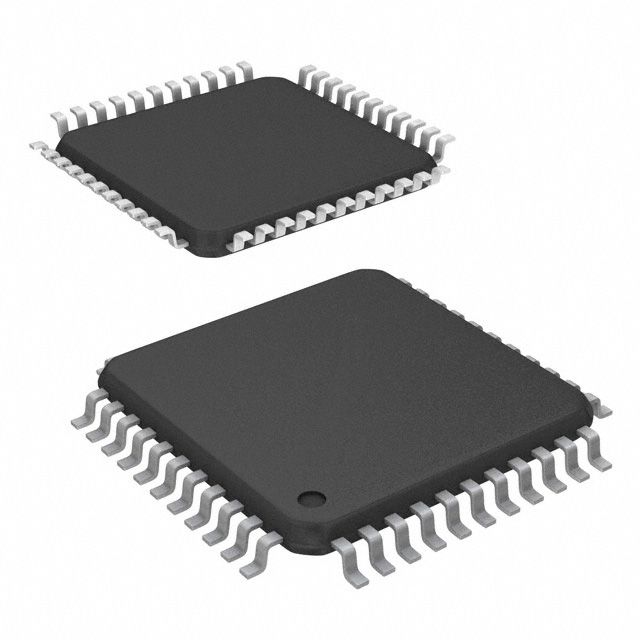Viz Specifikace pro podrobnosti o produktu.

AT89C51CC03C-RLTIM
Product Overview
Category
AT89C51CC03C-RLTIM belongs to the category of microcontrollers.
Use
It is primarily used for embedded systems and various electronic applications.
Characteristics
- Microcontroller with advanced features
- High-performance and low-power consumption
- Wide range of input/output options
- Integrated memory and peripherals
- Real-time clock functionality
Package
AT89C51CC03C-RLTIM is available in a compact and durable package, suitable for surface mount technology (SMT) applications.
Essence
The essence of AT89C51CC03C-RLTIM lies in its ability to provide efficient control and processing capabilities for electronic devices and systems.
Packaging/Quantity
This microcontroller is typically packaged in reels or trays, with varying quantities depending on the manufacturer's specifications.
Specifications
- Architecture: 8-bit
- Clock Speed: Up to 40 MHz
- Flash Memory: 64 KB
- RAM: 2 KB
- EEPROM: 2 KB
- Input/Output Pins: 32
- Timers/Counters: 3
- Serial Communication: UART, SPI, I2C
- Analog-to-Digital Converter: 8 channels, 10-bit resolution
Detailed Pin Configuration
- VCC - Power supply voltage
- GND - Ground
- P0.0 - Port 0, Pin 0
- P0.1 - Port 0, Pin 1
- P0.2 - Port 0, Pin 2
- P0.3 - Port 0, Pin 3
- P0.4 - Port 0, Pin 4
- P0.5 - Port 0, Pin 5
- P0.6 - Port 0, Pin 6
- P0.7 - Port 0, Pin 7
- RST - Reset pin
- P1.0 - Port 1, Pin 0
- P1.1 - Port 1, Pin 1
- P1.2 - Port 1, Pin 2
- P1.3 - Port 1, Pin 3
- P1.4 - Port 1, Pin 4
- P1.5 - Port 1, Pin 5
- P1.6 - Port 1, Pin 6
- P1.7 - Port 1, Pin 7
- XTAL1 - Crystal oscillator input
- XTAL2 - Crystal oscillator output
- P2.0 - Port 2, Pin 0
- P2.1 - Port 2, Pin 1
- P2.2 - Port 2, Pin 2
- P2.3 - Port 2, Pin 3
- P2.4 - Port 2, Pin 4
- P2.5 - Port 2, Pin 5
- P2.6 - Port 2, Pin 6
- P2.7 - Port 2, Pin 7
- ALE/PROG - Address Latch Enable/Program pulse
- PSEN - Program Store Enable
- EA/VPP - External Access Enable/Voltage Programming Pulse
Functional Features
- High-speed processing capabilities
- On-chip memory for program storage and data handling
- Multiple communication interfaces for seamless integration with other devices
- Real-time clock functionality for time-sensitive applications
- Flexible input/output options for versatile connectivity
- Built-in timers/counters for precise timing operations
- Analog-to-digital converter for sensor interfacing
Advantages and Disadvantages
Advantages
- Powerful processing capabilities
- Low power consumption
- Compact size and surface mount package
- Real-time clock functionality
- Extensive input/output options
Disadvantages
- Limited memory capacity compared to some other microcontrollers
- May require additional external components for certain applications
Working Principles
AT89C51CC03C-RLTIM operates based on the principles of a typical microcontroller. It executes instructions stored in its internal flash memory, processes data, and interacts with external devices through its input/output pins. The real-time clock feature ensures accurate timekeeping and synchronization in time-sensitive applications.
Detailed Application Field Plans
AT89C51CC03C-RLTIM finds applications in various fields, including but not limited to: 1. Industrial automation 2. Home automation systems 3. Automotive electronics 4. Medical devices 5. Consumer electronics 6. Internet of Things (IoT) devices 7. Robotics 8. Security systems
Seznam 10 běžných otázek a odpovědí souvisejících s aplikací AT89C51CC03C-RLTIM v technických řešeních
Sure! Here are 10 common questions and answers related to the application of AT89C51CC03C-RLTIM in technical solutions:
Q: What is the AT89C51CC03C-RLTIM microcontroller? A: The AT89C51CC03C-RLTIM is a high-performance, low-power, 8-bit microcontroller from Atmel.
Q: What are the key features of the AT89C51CC03C-RLTIM? A: Some key features include 64KB Flash memory, 2KB RAM, 4-channel 10-bit ADC, UART, SPI, I2C, and multiple timers/counters.
Q: What are some typical applications of the AT89C51CC03C-RLTIM? A: It can be used in various applications such as industrial control systems, home automation, robotics, and automotive electronics.
Q: How do I program the AT89C51CC03C-RLTIM microcontroller? A: You can use an In-System Programmer (ISP) or a compatible development board with a programming interface to load your code onto the microcontroller.
Q: Can I use C language for programming the AT89C51CC03C-RLTIM? A: Yes, you can use C language along with the Keil C51 compiler or other compatible compilers to write code for this microcontroller.
Q: What is the maximum clock frequency supported by the AT89C51CC03C-RLTIM? A: The microcontroller supports a maximum clock frequency of 40 MHz.
Q: Does the AT89C51CC03C-RLTIM have any built-in communication interfaces? A: Yes, it has UART, SPI, and I2C interfaces, which allow for easy communication with other devices.
Q: Can I interface external memory with the AT89C51CC03C-RLTIM? A: Yes, the microcontroller supports external memory interfacing through its address and data bus.
Q: How many timers/counters are available in the AT89C51CC03C-RLTIM? A: It has three 16-bit timers/counters and one 8-bit timer/counter.
Q: Is the AT89C51CC03C-RLTIM suitable for low-power applications? A: Yes, it is designed to operate at low power and has various power-saving modes to conserve energy.
Please note that these answers are general and may vary depending on specific requirements and implementations.

